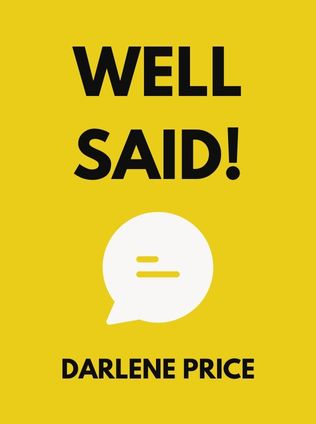
Well Said!
Presentations and Conversations That Get Results
By Darlene Price
Published 10/2012
About the Author
Darlene Price is a seasoned expert in the field of communication and presentation skills. As the president and founder of Well Said, Inc., she has dedicated her career to helping professionals deliver high-impact presentations and effective communication. Her book, "Well Said! Presentations and Conversations That Get Results," reflects her extensive experience, industry research, and client surveys, offering a comprehensive guide to mastering the art of presentation.
Main Idea
The core premise of "Well Said!" is that effective presentations are not just about delivering information but about engaging and persuading your audience. The book emphasizes understanding the audience's perspective and needs, organizing content persuasively, and delivering with confidence and clarity. By following Darlene Price's expert guidelines, anyone can improve their presentation skills and achieve better results in any business situation.
Table of Contents
- Introduction
- The Most Important Element: The Audience
- How to Persuade a Decision Maker
- Establishing Credibility
- Crafting Your Presentation
- Developing Content that Involves and Engages Your Audience
- Designing and Presenting Effective PowerPoint Slides
- Preparing for a Powerful Performance
- Using Effective Body Language to Show Confidence
- Conveying a Professional Image Through Dress and Appearance
- Speaking with the Voice of Authority
- Leveraging the Language of Leadership
- Handling Q&A with Credibility and Finesse
- Planning and Conducting Powerful Conversations
- Writing Emails that Get Results
- Facilitating Effective Meetings in Person and via Telephone
- Delivering Winning Webinars
- Leading Team Presentations
- Afterword
Analyzing and Explaining Each Idea
The Most Important Element: The Audience
Darlene Price starts with a crucial point: the most important element of any presentation is the audience. Understanding your audience’s needs, expectations, and challenges is fundamental to crafting a successful presentation. She introduces 10 critical questions to analyze your audience, such as "Who are they?", "What are their main issues and challenges?", and "How does your message solve their problem?"
By addressing these questions, you can tailor your presentation to resonate with your audience.
- Send out a questionnaire or survey to gather information.
- Read the latest articles relating to your audience's industry.
- Visit their facility or office to understand their environment.
- Converse and mingle with participants as they enter the room.
How to Persuade a Decision Maker
The skill of persuasion is critical when presenting to decision makers. Darlene Price outlines four key motivators: profit, pleasure, power, and prestige. Understanding these motivators allows you to frame your message in a way that appeals to your audience's interests.
"The three top communication qualities deemed most promotable and persuasive are: Clarity, Conciseness, and Credibility." - Darlene Price
She also shares the 10 biggest complaints from senior leaders about speakers, which include giving too much information, rambling, and lacking confidence. To combat these issues, practice the Three Cs: be clear, concise, and credible.
Establishing Credibility
Credibility is essential in persuading your audience. Price explains that decision makers evaluate you based on three factors: visual (how they see you), vocal/verbal (how they hear you), and relational (how they feel about you). To enhance your credibility, focus on:
- Visual Factor: Body language, dress, appearance, and room setup.
- Vocal/Verbal Factor: Voice tone, vocal variety, and persuasive words.
- Relational Factor: Audience focus, friendly demeanor, and humor.
For example, maintaining eye contact and using a confident tone can significantly boost your credibility.
Crafting Your Presentation
A persuasive presentation consists of three sections: the opening, the body, and the close. Each section has specific elements:
Sign up for FREE and get access to 1,400+ books summaries.
You May Also Like
The Subtle Art of Not Giving a F*ck
A Counterintuitive Approach to Living a Good Life
By Mark MansonRich Dad Poor Dad
What the Rich Teach Their Kids About Money - That the Poor and Middle Class Do Not!
By Robert T. KiyosakiHow To Win Friends and Influence People
The All-Time Classic Manual Of People Skills
By Dale CarnegieQuiet: The Power of Introverts
The Power of Introverts in a World That Can't Stop Talking
By Susan Cain



















